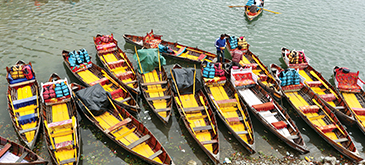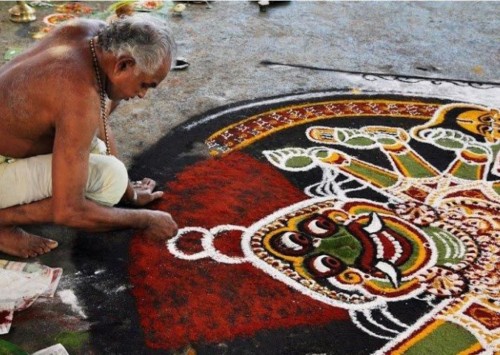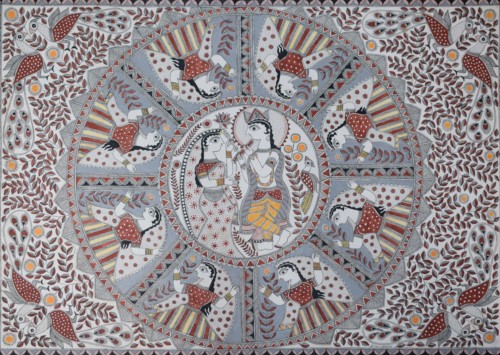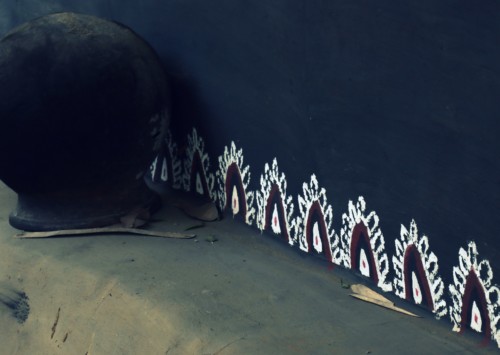The tradition of Aipan
Understanding a craft of religious importance, and how the ways and motifs of Aipan are being preserved by artistically devoted women in Nainital, the city of lakes in Uttarakhand.
Sunlight shyly seeped in through a veil against the window and fell over five women dressed in plain garbs, their hands moving with fidelity, striving to create masterpieces with the brick red and off-white colors of Aipan, and the sheer rawness of heritage being crafted made the aura rustic.
A form of ritualistic painting, Aipan was developed at the hands of women of Uttarakhand, a state in northern India.
A derivative of the word arpan, or a devoted offering, Aipan is deeply linked to the religious sacraments of the Kumaon region, which is one of the two divisions of Uttarakhand, the other being Gharwal.
Aipan has multiple variations and modifications, known by different names in different states of India. It is Alpana in Bengal, Arichan in Bihar, Bhuggul in Andhra Pradesh, Satiya in Gujrat, Chowk Pooran in Uttar Pradesh, Madne in Rajasthan and Kolam in south India.
Made using a thick paste of ground rice, the sacred motifs of Aipan were traditionally painted at the entrance of a house, the courtyard, and at places of worship, but now the applications have diversified. The motifs are now hand-painted on fabrics as modern prints on kurtas (tunics), saris, and other apparel and products. Clay idols or Dikara, are also painted with Aipan paste to make bio-degradable idols for worship.
Vimla Shah, an artist who practices Aipan in Nainital is passing on the legacy by teaching it to many others. An independent woman, she is an inspiration in the region.
Shah says, “As a young girl, I used to help my mother create Aipan Chowki and Jyonti Patka”, Jyonti is a ceremony considered auspicious and practised on births and weddings. It is where the art of Jyonti Patka has evolved from. The lines in the art depict a guided invitation by the Himalayas towards enlightenment, with floral and geometric designs and the central theme of the art revolving around a tree which revolutionises the theme of Kalpavriksha, or the tree of life.

Clockwise from top left: Nav Durga Chowki, Laxmi Narayan Chowki, Laxmi Chowki, Saraswati Chowki, Chetu Chowki and Shivarchan Peeth Chowki
The artistic ingenuity of the Aipan tradition is seen through the intricacy of its Chowki, which are religious motifs enclosed in a frame having particular meanings and applications. For example, Saraswati Chowki is for when a child begins formal education to give him/her an auspicious start with the blessing of Saraswati, the goddess of art and wisdom. The Chamunda Hast Chowki is made for havan (auspicious fire) or yagya (sacrificial fire), the Nav Durga Chowki is used for ritualistic Devi pujas (goddess worship) and the Shivarchan Peeth is used for worshipping Shiva, the reigning God. The culture of Aipan Chowki is widely practiced by married women in north India while observing Karva Chauth, a fasting day observed for the well-being of their husbands.
Vimla Shah says “After my marriage, my sister-in-law gave in a good word for me at an NGO named Nehru Trust in Nainital, which focuses on the upbringing of traditional crafts. That is when I received my first order by the district manager of that time, Aradhna Shukla, to create 50 pieces of Aipan and Jyonti Patka.”
“Later I received an order from the High Court of India to create 80 pieces of Aipan and 10 Jyonti Patka, to be submitted in a span of five days”, she says.
Also Read – India Art Festival returns after two years.
Live Aid: Inspiring artists to take up global causes.
Shah has been awarded by the chief minister of Uttarakhand for her immense contribution in preserving the Kumaoni art, and continues to be devoted towards her work.
















